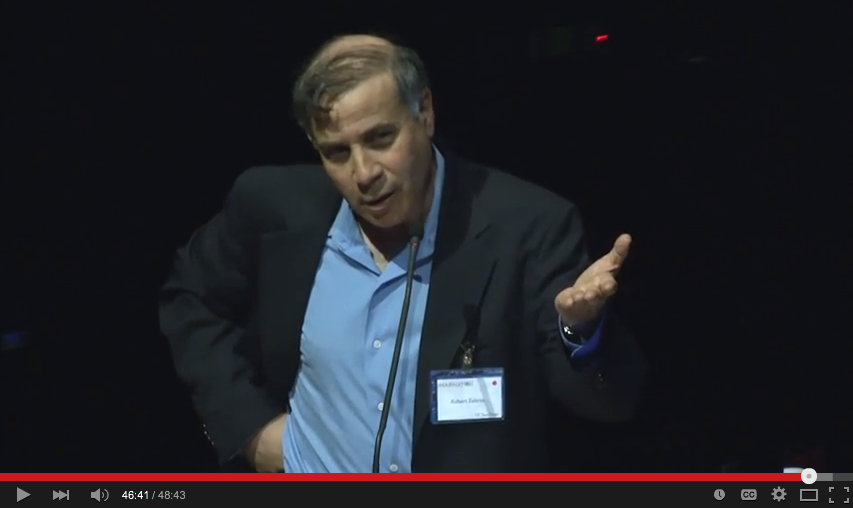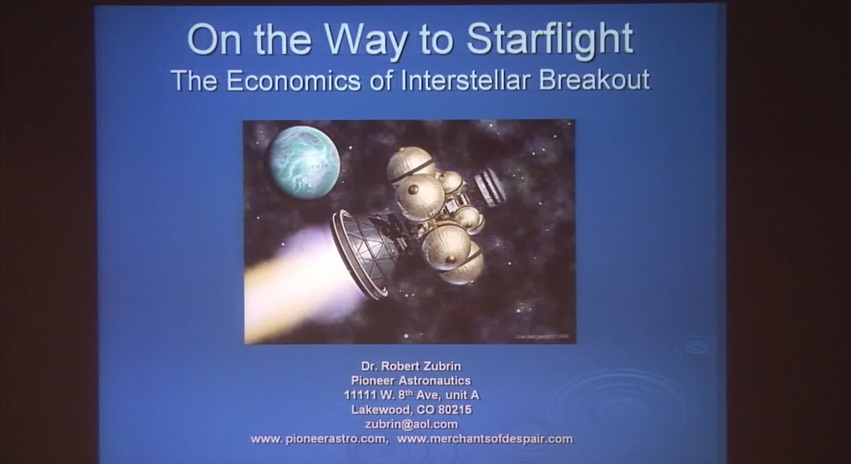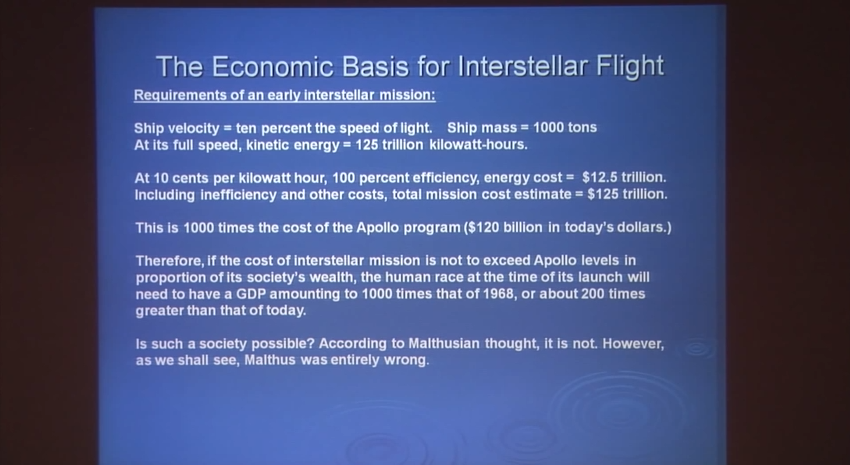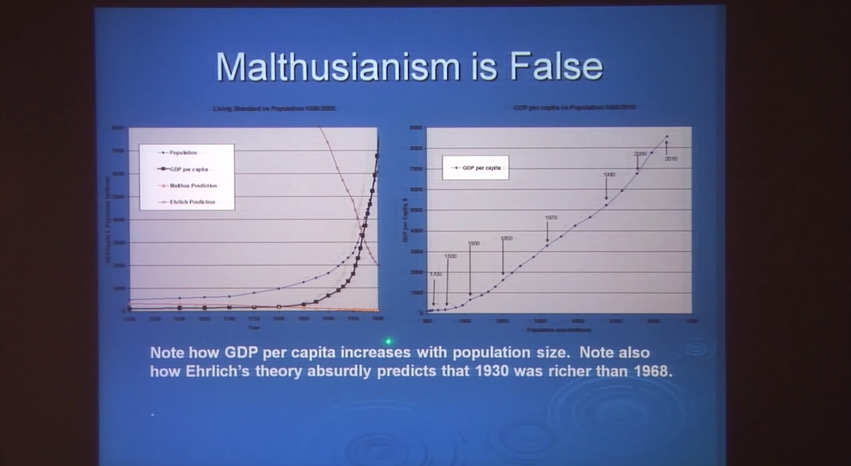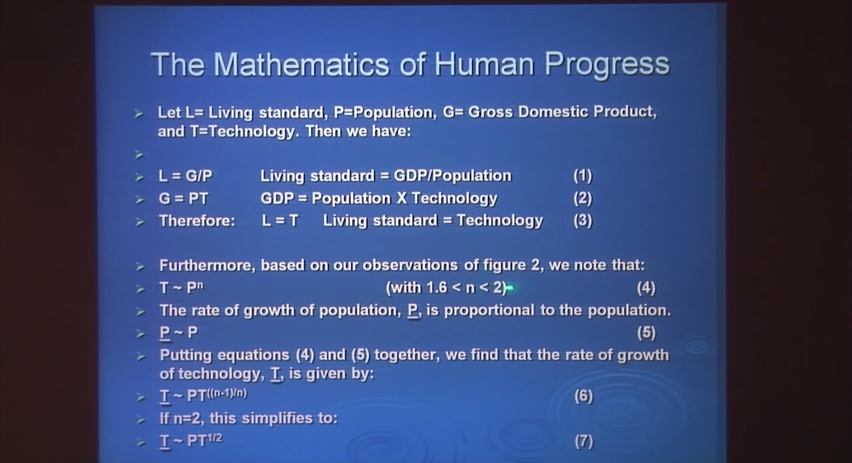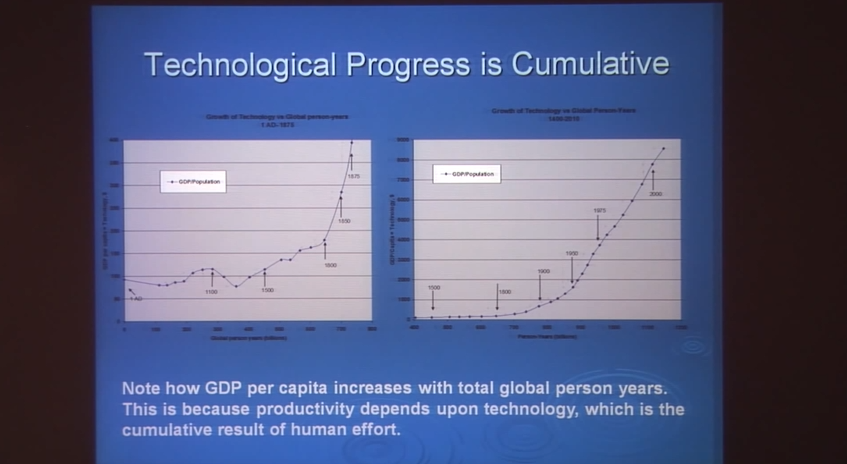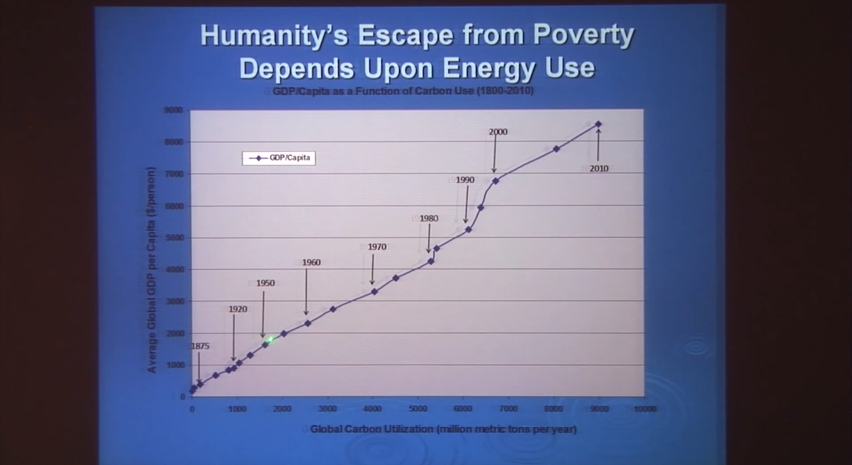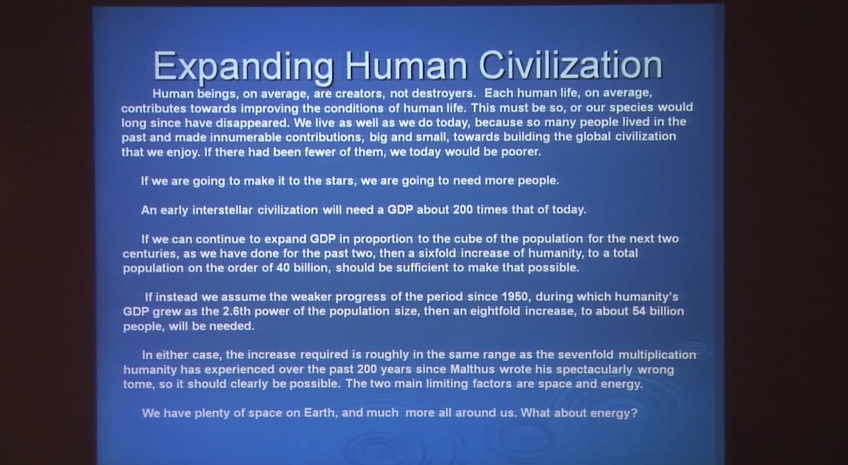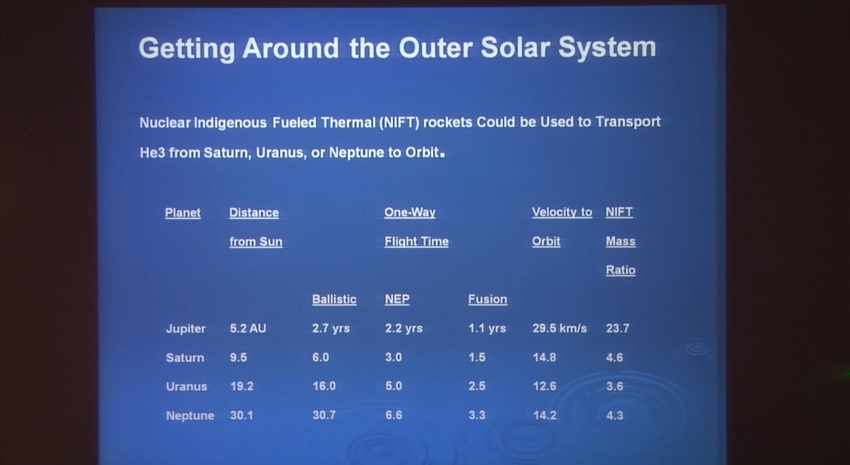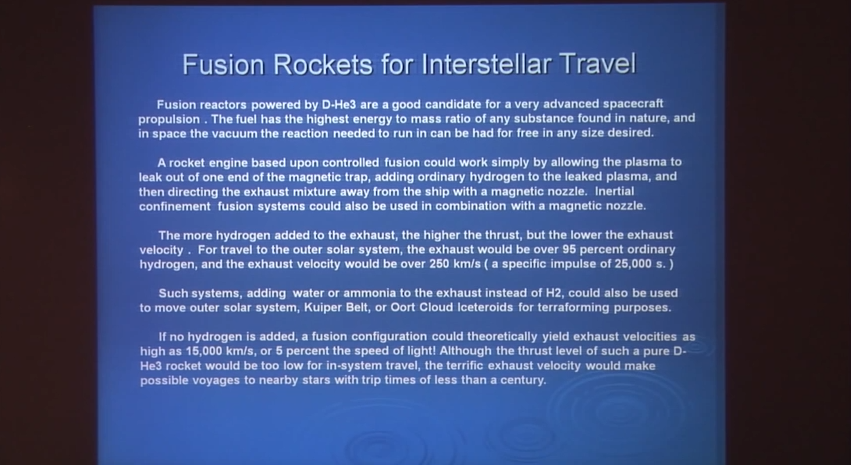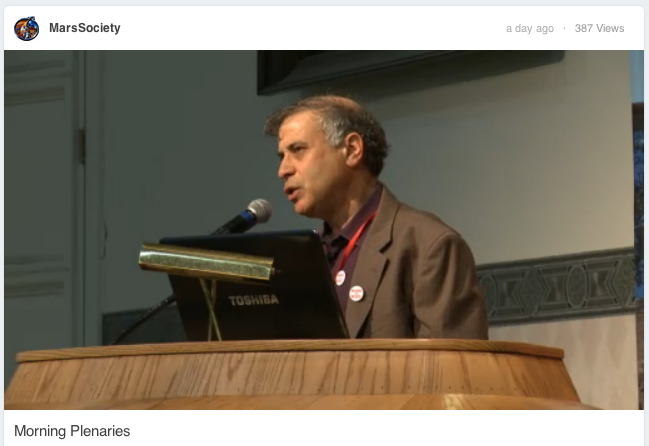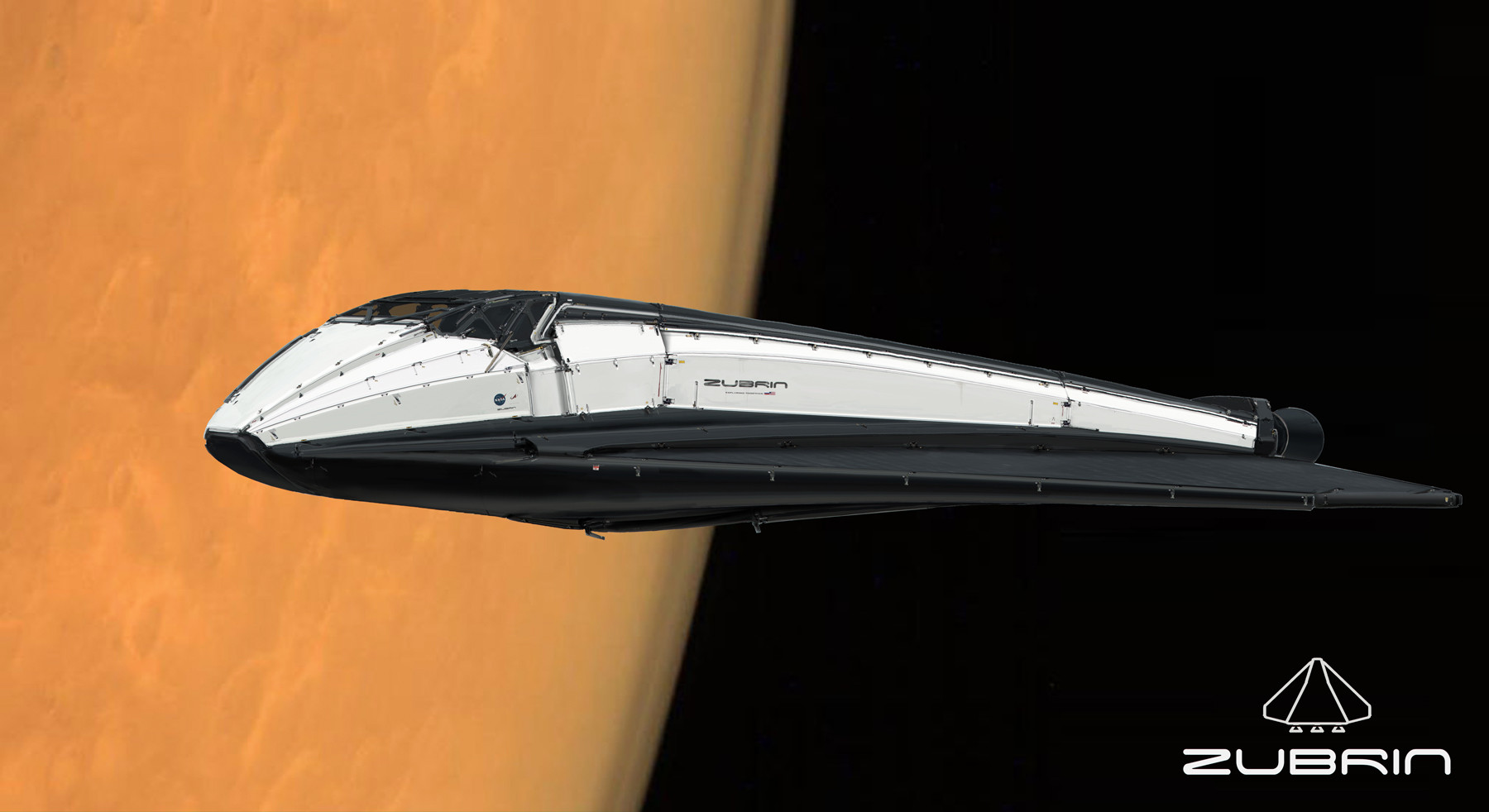
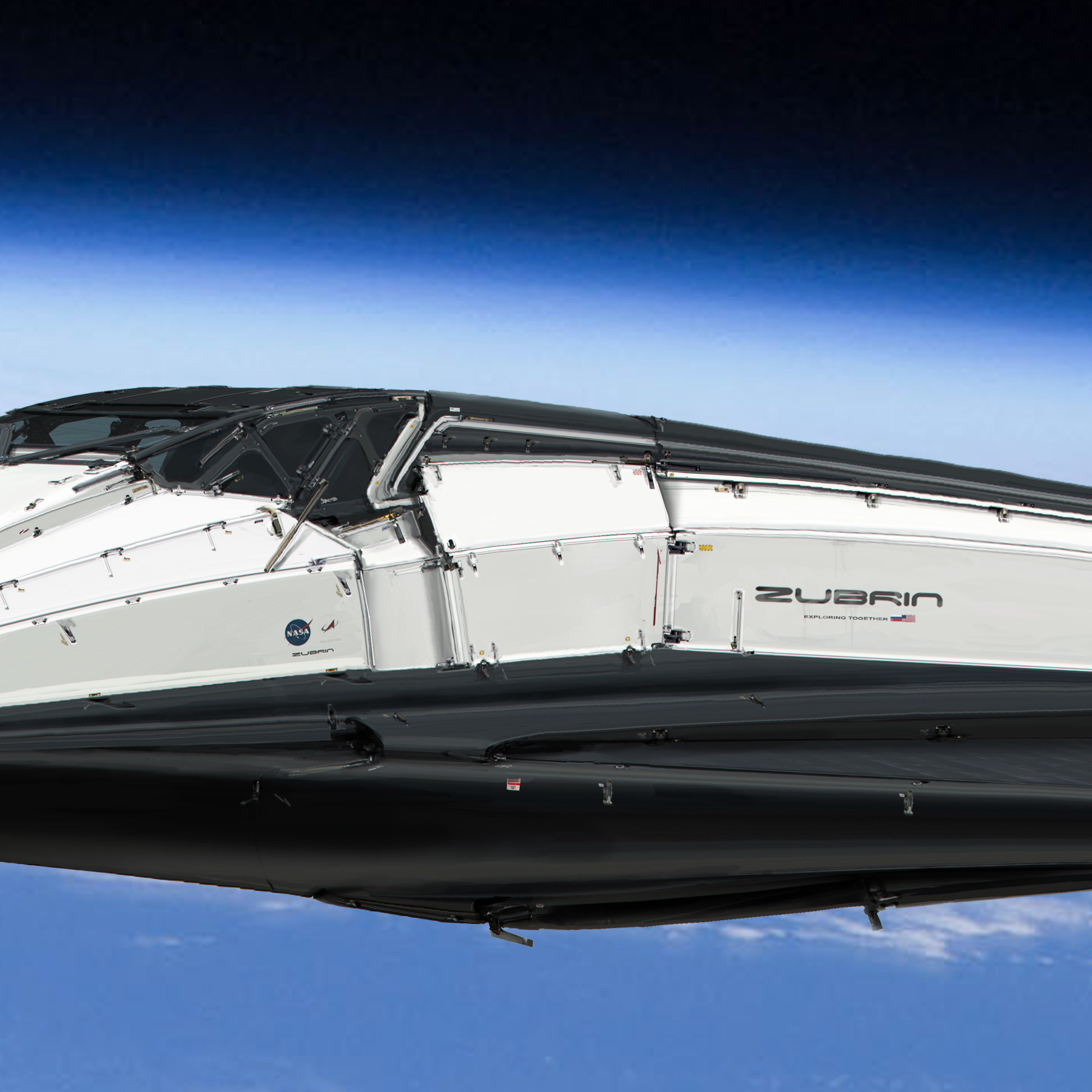
Category Archives: Bob Zubrin
Bob Zubrin: Economics of Interstellar Starflight
[Factual Fiction transcript]: Now, deuterium helium 3 – of any substance known in nature – has the highest energy per unit mass. Okay – antimatter has more energy per unit mass but it’s not found in nature you have to make it with energy from something else and currently that’s done with an efficiency of ten to the minus six. Uh, but the – ah, if you have deuterium, ah, helium 3 fusion you can make a rocket, ah, out of that. If you – it can either be magnetic confinement or inertial but either way to repel the plasma away from it. Um. If you dilute that plasmid with other mass – for example with hydrogen – you can lower the specific impulse and increase the thrust. And that would be done for interplanetary travel – or for instance move what I call ‘ice-troids’ which are asteroidal kind of objects made of volatile material like frozen ice or ammonia or whatever, okay, which you might want to do for terraforming purposes or for other reasons. Uh. But, if you actually wanna go to the stars, ah, you want to get the highest possible exhaust velocity, uhp, the deuterium helium 3 reaction gives you an ideal exhaust velocity of about seven percent the speed of light. And if you take into account inefficiencies that are likely to exist in a real rocket maybe you can get five percent the speed of light as an exhaust velocity. With appropriate staging rockets can be built to achieve about twice their exhaust velocity. For example, Space Shuttle main engine has an exhaust velocity of about four kilometers a second to achieve orbit the Shuttle moves to eight kilometers a second. So with various staging techniques and so forth you can get a rocket up to about twice its exhaust velocity.
So if you have a rocket that can do about five percent the speed of light, exhaust velocity you can make starships that have ten percent the speed of light final velocity. Then once they get up to speed I believe interstellar spacecraft can be slowed down using a magnetic sail which is basically deploying a loop of super-conducting wire which is in interstellar space creating a magnetic field, using that – it, it it, basically that would repel the interstellar plasma that would create drag, interstellar gas would be ionized and turned into plasma and repelled its just like solar wind hitting the Earth’s magnetosphere and it goes around it many of you have seen diagrams of that kind of thing. Well that actually creates drag around the Earth – fortunately not that much so we’re not falling into the sun at the moment, but, the, uh, it could be used to slow down interstellar spacecraft down to the – what you might call interplanetary class velocities, at which point more conventional technologies could be used to maneuver to the planet of interest.
So, and, and I might comment upon this. Fusion is a promising energy source for Earth, um, the program was going fairly well until the 1980s when it was internationalized. Ah, and, ah – no I mean that, because I worked in the fusion program. Until the 1980s we had a rather dynamic program because of the competition of the US program against the Soviet program the European program the Japanese program. All four were constantly challenging, trying to upstage each other at conferences, show their latest results their plans for the next machine and so forth – and this put some competitive drive into it. Ah, around 1985 the bureaucrats got together and said, “why are we doing this wasteful competition, let’s merge our programs into this thing called ITER” – the International Tokamak Experimental Reactor – it then took them thirty years to agree on where to put it. But they went to a lot of fun meetings in the meantime in Kyoto Geneva everywhere. And, ah, and and and the progress basically stopped after 1990, when no new national machines were made.
But we’re now moving into a more affluent world, and, just as we are seeing privately funded spacecraft companies we’re going to see privately funded fusion companies. Ah, because there’ll be people in the private sector who have resources to give this kind of thing a try. And I think we’ll have much more determined kinds of programs focused kinds of programs and I think it will eventually succeed.
You know fusion, the other thing about fusion, is, uh – well put it this way, steam engines were first developed for, um, pumping out mines, of water. But they didn’t really become efficient until they were developed for the purpose of propelling steam, boats. And nuclear reactors – the first practical incarnation of the nuclear reactor was to propel submarines, okay, and uh, I think developing fusion reactors for space propulsion might put the discipline on it to make inexpensive efficient fusion reactors which could then become available for commercial utilization. So I think there’s ah, ah, interplay here, between technology that’s developed for spaceflight and spaceflight using that technology to make much more available various resources for Earth, and as well as practical energy resource for Earth, and, as that technology’s developed towards its limit opening up a path to the stars.
The biggest problem in the world today is poverty. It’s not global warming or terrorism. Poverty. Poverty kills people. Through starvation, malnutrition, disease, ignorance, brutality, through every mechanism we can think of. We cannot be satisfied with the way things are. We cannot stop progress. No one in this VR would be satisfied if they were at half the world average. Or below half the world’s average – which half the world’s population is.
The main issue here is the continuation of progress, ok, there, there’s really, two ideas in contest here, on, on Earth, and, they have very real consequences. Ideas have consequences. Okay, there is this idea – which is essentially anti-humanist – uh, which is uh, that the world’s resources are fixed, and so, each additional person is a detriment to the well-being of everyone else, and, every nation is fundamentally the enemy of every other nation, and, every race the enemy of every other race, um, and ah, we should all try to keep each other down, okay, and, you know, the the the only outcome of this world view can be stagnation tyranny war and genocide. And in fact we’ve seen this. Uh, in the twentieth century. Hitler 1941 the laws of existence require killing so that the better may live. Okay, you know, and, and if these ideas are accepted now they could lead to the worst ideas you could possibly imagine.
I mean, if these ideas are accepted by the Chinese leadership for example then the existence of the United States population is intolerable because we’re four percent of the world’s population using twenty-five percent of the world’s oil. On the other hand – and if these ideas are accepted by American strategic thinkers they can have nothing but animosity toward the rise of China and other third-world to affluence ‘cause now there’s going to use up the oil that we want and so forth. Okay, but, if you take the other point of view, that human beings on net are creators – and by the way, this idea is demonstrably true, because if human beings on average destroyed more than they created there’d be nothing here. Okay.
It must be the case that human beings on average create more than they destroy, but, and if you embrace that truth, then, you see every new person born on the world as potentially a friend, every nation a friend and potentially a friend of every other nation. The US is the greatest friend of China not just because we buy their DVD players but because that four percent of the world’s population is producing half the world’s inventions. It’s true, we are. But we can be proud of that because we’d be a lot better off if the Chinese were doing their share so it’s really good for us if the sons and daughters of Chinese peasants go to the university to become scientists and engineers, so they can start contributing their talent to the general flow of human progress. So we’re not enemies at all. Okay, because, the real resource is human creativity. Okay, so, the, and, and the only thing sustainable is human progress – if you try to enforce stasis on society and limit us to one particular technology or form of resources, yeah then that one will run out. It is the capacity to create that creates resources.
Bob Zubrin at the Ames Research Center Director’s Colloquium
Factual Fiction transcript (starting ~50:00 min):
Mars is where the science is, it’s where the challenge is, and it’s where the future is. It’s where the science is because, okay, Mars was once a warm planet, it had liquid water on its surface for more than a billion years – which is about five times as long as it took for life to appear on Earth after there was liquid water here. So if the theory is correct that life is a natural development from chemistry, or if we have liquid water of various elements and sufficient time – life should have appeared on Mars even if it subsequently went extinct. And if we can go to Mars and find evidence of past life, we will have proven that life is a general phenomena of the universe.
Okay, or, alternatively, if we go to Mars and find plenty of evidence of past bodies of water but no evidence of fossils or life we could say that the development of life from chemistry is not sort of a natural process of high-probibility but includes elements of free chance and we could be alone in the universe. Furthermore if we can go to Mars and drill? Because there’s liquid water underground on Mars – reach the ground water, there could be life there now. And if we could get hold of that, look at it and examine its biological structure, bio-chemistry, we could find out if life as it exists on Mars is the same as Earth life.
All Earth-life at the biochemical level is the same. We all use the same amino acids, the same methods of replicating information – RNA and DNA and all that. Is that what life has to be?? Or could life be very different from that. Are we what life is or are we just one example drawn from a much vaster tapestry of possibilities. This is real science. This is fundamental questions that thinking men and women have wondered about for thousands of years. The role of life in the universe. This is very different from going to the moon and dating craters in order to produce enough data in order to produce a paper to publish in the Journal of Geophysical Research and get tenure, okay. The, the – um…okay, um – this is, this is, okay, hypothesis driven critical science. This is the real thing.
Second, the Challenge. Okay, you know, I think societies are like individuals. We grow when we challenge ourselves, we stagnate when we do not. Humans to Mars would be a tremendously bracing challenge for our society, it would be tremendously productive – particularly among youth. Okay, Humans-to-Mars program would say to every kid in school today, “Learn your science and you could be an explorer of new worlds.” We’d get millions of scientists, engineers, inventors, technological entrepreneurs, doctors, medical researchers out of that. And the intellectual from that would enormously benefit us. It would dwarf the cost of the program.
And then finally it’s the future. Mars is the closest planet that has on it all the resources needed to support life and therefore civilization. If we do what we can do in our time to establish that little Plymouth Rock settlement on Mars, then, five hundred years from now there’ll be new branches of human civilization on Mars and I believe throughout nearby interstellar space. But – wha – you know look: I ask any American what happened in 1492 they’ll tell me, “Well Columbus sailed in 1492” and that is correct, he did. But that’s not the only thing that happened in 1492. In 1492 England and France signed a peace treaty. In 1492 the Borgias took over the Papacy. In 1492 Lorenzo de’ Medici the richest man in the world died. Okay, a lot of things happened. If there had been newspapers back in 1492 – which there weren’t, I wish there had been – then those would have been the headlines – not this Italian weaver’s son taking a bunch of ships and sailing off to nowhere. Okay, but, but Columbus is what we remember – not the Borgias taking over the Papcy. Okay.
Well 500 years from now people are not going to remember which faction came out on top in Iraq! Or Syria, or, whatever. And the, the, the – who was in and who was out. And, and you know, but, they will remember what we do to make their civilization possible. Okay. So, this is the most important thing we can do. The most important thing we can do in this time. And if you have it in your power to do something great and important and wonderful in your time then you should.
Robert Zubrin: “To Mars, Not the Moon”
As we celebrate the 45th anniversary of the Apollo 11 moon landing, our space program finds itself adrift. But this need not be so. The great deeds we accomplished then demonstrate what we can do when we are brave. The time is overdue for America to commit itself to a bold new venture in space: the human exploration and settlement of Mars.
We’re ready. Despite the greater distance to Mars, we are much better prepared today to send humans to Mars than we were to launch humans to the moon in 1961 when President John F. Kennedy challenged the nation to achieve that goal. Given the will, we could have our first teams on Mars within 10 years.
It needn’t break the bank, either. If done intelligently – with expenditures made for the purpose of accomplishing the mission, rather than the mission designed for the purpose of justifying expenditures – the cost of the Mars program would be about $20 billion to develop all the hardware needed. After that, each mission would cost between $1 and $2 billion.
$20 billion is not a trivial sum, but over 10 years it would represent about 12 percent of NASA’s budget, or less than 0.4 percent of the U.S. military budget. It’s a sum that this country can easily afford.
But why do it? There are three reasons.
1) For the Knowledge: Our robotic probes have shown that Mars was once a warm and wet planet that could have evolved and supported life. If this possibility could be confirmed by actual finds of fossils on the Martian surface, it would show that the origin of life is not unique to the Earth, and thus by implication reveal a universe that is filled with life and probably intelligence as well. From the point of view of humanity learning its true place in the universe, this would be the most important scientific enlightenment since Copernicus.
Now, robotic probes can help out in such a search, but by themselves are completely insufficient. Fossil hunting requires the ability to travel long distances through unimproved terrain, to climb steep slopes, to do heavy work and delicate work, and to exercise very subtle forms of perception and on-the-spot intuition. All of these skills are far beyond the abilities of robotic rovers. No, field paleontology requires human explorers, real live rockhounds on the scene.
2) For the Challenge: Nations, like people, thrive on challenge and decay without it. The space program itself needs a challenge. Consider: Between 1961 and 1973, under the impetus of the moon race, NASA produced a hundred times the rate of technological innovation it has shown since, for an average budget in real dollars only about 20 percent more than today. Why? Because it had a goal that made its reach exceed its grasp. You don’t need to develop anything new if you are not doing anything new. Far from being a waste of money, forcing NASA to take on the challenge of Mars is the key to giving the nation a real technological return for its space dollar.
A bold humans-to-Mars program would also be an challenge to every kid in the country: “Learn your science and you can become part of pioneering a new world.” There will be over 100 million kids in our nation’s schools over the next 10 years. If a Mars program were to inspire just an extra 1 percent of them to scientific educations, the net result would be 1 million more scientists, engineers, inventors, medical researchers and doctors, making innovations that create new industries, finding new medical cures, strengthening national defense, and increasing national income to an extent that dwarfs the expenditures of the Mars program.
3) For the Future: Mars is not just a scientific curiosity, it is a world with a surface area equal to all the continents of Earth combined, possessing all the elements that are needed to support not only life, but technological civilization. As hostile as it may seem, the only thing standing between Mars and habitability is the need to develop a certain amount of Red Planet know-how. This can and will be done by those who go there first to explore.
Mars is the New World. Someday millions of people will live there. What language will they speak? What values and traditions will they cherish, to spread from there as humanity continues to move out into the solar system and beyond? When they look back on our time, will any of our other actions compare in value to what we do today to bring their society into being?
Today, we have the opportunity to be the founders, the parents and shapers of a new and dynamic branch of the human family, and by so doing, put our stamp upon the future. It is a privilege not to be disdained lightly.
http://www.usnews.com/debate-club/should-we-go-back-to-the-moon/to-mars-not-the-moon
Mars Society Promotional Video
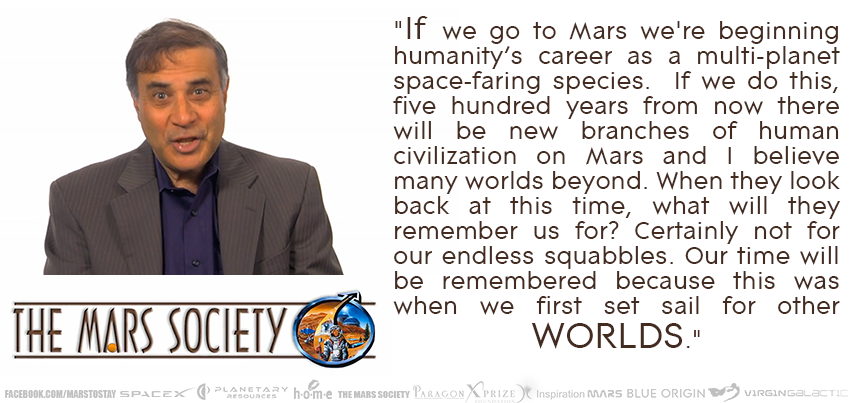
Bob Zubrin on ‘Mars to Stay’ at the 2013 International Mars Society Convention
“The idea of a one way mission, that, you know, you go to Mars, spend two years there, then have a suicide pill – or you go there at age 65 live for twenty years and then check out – no. That is not attractive. But what is very attractive is the idea of the “Normandy Beach Approach” – which is, you go to Mars, one way, not with the intent of dying there – but with the intent of living there. You take the beach. You send, you send people there not with the intent of abandoning there but with the intent of joining them there with more people more equipment more supplies more of everything. You back them up and you take the planet. And, um, that’s the proper concept for a one way mission – and if you’re prepared to do that, then that is the most efficient mission by far.”
Zubrin on Inspiration Mars (‘Destination Mars’ – Audio Interview)
Robert Zubrin starts 28 minutes into ‘Destination Mars’ – Frontier Journeys to the Red Planet:
“The greatest hope here is, this proposal that’s been advanced by Dennis Tito, known as Inspiration Mars, to send two people on a Mars fly-by mission, which, will not accomplish very much exploration – except that it will prove that human interplanetary flight is possible. It will thus – as it were – take the dragons off the map…eliminate the paralyzing fear that is preventing NASA from embracing ‘humans to Mars’ and leaving them without basically any goals for their human spaceflight program right now. But furthermore in terms of a private flight as such, see, the two person fly-by is doable probably for less than a billion dollars if done in the private sector – for less than two, really, if done by major contractors.
“I proposed such a mission to Golden, in 1995, but, he passed. But Tito while he doesn’t have a billion dollars to spend, has tens of millions, which is enough to start a fund-raising effort that could do this, which is enough to raise a billion, and – if – they – do – this – mission, they will have sufficient credibility to raise funds from the broad public to fund, um, privately funded human Mars exploration. And, see, there’s seven billion people on this planet, of which a billion live in the advanced sector and of which at least ten percent believe in a positive future in which it is important that humans expand into space. That would be enough to fund the colonization of Mars, if ya had them organized. So in other words the harvest is plentiful but the gatherers are few. And, the Tito vision could actually be the thing that raises the flag high enough to rally the forces to make this possible.”
“I don’t think this can be done for profit – this needs to be done for hope and faith. Okay? Other colonization efforts in the past have been done for that reason. The Pilgrims, the Mormons, the Jews going to Israel – and by the way they were all supported by fund-raising organizations of their colleagues who did not go, but who raised logistics to make it possible for the colonists to go, based on a belief that this was important.”
“I think that we have a game-changer here with respect to ‘humans to Mars’ and the Tito mission. Mars is where the science is, it’s where the science is, it’s where the challenge is, it’s where the future is. It’s where we’ll find out if life developed where it had a reasonable chance to develop. And it’s where we’re going to find out if we can become a spacefaring multi-planet species. It’s the closet planet with all the resources needed to support life and therefore civilization. And this is the challenge that’s been staring NASA in the face basically since the Apollo missions ended. They’ve been frantically looking for, you know, anything to do. And right now we have a human spaceflight program, where, if we ask them, “where are we going to be 10 years from now?” The answer would be “exactly where we are now.” They’re operating with an Apollo scale budget actually…that is, if you took NASA’s average funding, from ’61 to ’73 and you add it all up, converted to today’s money, divided by 13 years, you’d come out with 20 billion a year. NASA’s budget this year is, you know, 17 billion. So it’s a little less, but, it’s not like it’s a factor of four less. Or anything of that sort. So it’s comparable to Apollo levels – and yet we don’t have anything like Apollo-era accomplishments. There are no goals, there is no focus – except, in the robotic program. That’s mission driven. That’s why it accomplishes things.”
“The human spaceflight program is basically constituent driven. It’s a way for NASA to spend money to give to contractors. I’m all for money to go to contractors – because I am a NASA contractor – but, it would be much better if it went to contractors that actually accomplished something.”
Robert Zubrin to Debate ‘Zero Growth’ Ideologue Phil Cafaro on April 15th
 Debate: Are People the Problem?
Debate: Are People the Problem?
Monday, April 15 from 7:00 PM to 8:30 PM
“The subject of the debate has everything to do with Mars exploration. ‘Zero Growth’ ideology is antithetical to human expansion into space, and opening the space frontier is completely subversive to Malthusian and related limited resources ideology.”
The planned debate, entitled “Are People the Problem?”, was occasioned by an article that Dr. Cafaro wrote in the Denver Post, arguing that immigration contributes to global warming, because by coming to America, immigrants increase their incomes, and thus their carbon footprints. This, says Dr. Cafaro, must be stopped.
In his anthology “Life on the Brink” (introduction by Paul and Anne Ehrlich, edited by Dr. Cafaro and Eileen Crist) he states that it is not only necessary to cut off immigration to America, but that the U.S. population needs to be reduced to 100 million people. According to Dr. Cafaro, “The last thing the world needs is hundreds of millions of more Americans.”
In addition, Dr. Cafaro requires that the world population be cut down from its current 7 billion to 2 billion, and recommends using the denial of U.S. foreign aid as a method to coerce Third World countries to accept population reduction. In addition, argues Dr. Cafaro in his included essay entitled “Is humanity a cancer upon the Earth?”, economic growth must be ended.
In the same book, contributing author David Foreman, the founder of Earth First and fellow leader of the “Apply the Brakes” anti-growth organization, objects to feminist interference in the family planning movement on the grounds that some feminists have the temerity to insist that a woman’s right to choose also includes the right to choose to have children. He says they have no such right.
This is going to be a significant debate. Dr. Cafaro’s views bring sharply into focus the anti-human and totalitarian implications of the ‘Zero Growth’ movement. In opposing him, Dr. Zubrin will make the case for human creativity and freedom.
BBC "Building a New Society in Space"
 |
| (Copyright: Science Photo Library) |
“…life on the Starship Enterprise may appear almost utopian but the way the ship – indeed the whole Federation is run – is essentially hierarchical. Humanity’s mission to “boldly go” is being undertaken by a quasi-military dictatorship. For a series originally billed by its creator as “wagon train in space”, it is hardly land of the free.”
“Is this really how we want to explore the cosmos and take our culture to the stars?”
“…they have renamed their mission control “mission support”, acknowledging that they are no longer completely in charge.”
“Mars is the test for humanity,” Long says. “It’s the test of our character and, to me, that should be the next destination for the human species – to colonise Mars, to set up a small station and develop it gradually. If we can’t crack Mars, then forget everything else that we have ambitions for.”
“People will have children… and at some point the Mars base breaks out of becoming a base and becomes an actual village – a real society with real people living real lives, with children in schools and community orchestras. All kinds of things that a base commander might think are completely extraneous.”
“Zubrin sees this as a natural, and inevitable, progression from hierarchy to locally accountable democracy and draws parallels with the colonisation of North America. “First you had independence from the West India Company, then ultimately from the British Crown and that’s how life is,” he says. “I think a Mars base may well start out as a bureaucratically structured entity but when you have people living real lives, they’re going to be pushing against the boundaries of that. And if you want to leave the colony, the easiest thing would be to get together with some other people and found additional colonies on Mars.”
“…they will also no longer consider Earth as home. “The whole point is to create new branches of human civilisation,” Zubrin explains. “It’ll have its own dialect, its own literature, own jokes and sense of humour. It’s going to be different, a different culture, and I think that’s good.”
Zubrin Advancing ‘Humans to Mars’ as Questioner at Mars Concepts 2012
Zubrin (as questioner in audience at about 1:22): “The purpose of the human, exploration program, inasmuch as it is cooperating with the robotics, exploration program, should be to prepare for human exploration not to prevent human exploration…and so…you really don’t want to get into this thing of “you can’t do your program, until we do my program”. And so that, for example, while the Mars Sample Return has a great deal of scientific merit – I’m not going to argue against the mission – ah…to say you cannot do a human mission, until you’ve done a sample return mission, to certify that the target site is lifeless, ah…doesn’t make any sense. In fact, if you did do a sample return mission and you found biological material at that site, that’s exactly where you’d want to send human explorations. You want to send human explorers to the most interesting sites, not to the least interesting sites. And, other things here…we clearly don’t need to do a Phobos mission before we do humans missions. You might want to do a Phobos mission, but to claim you have to do a Phobos mission before you do humans missions, its not relevant. To say you have to do a humans to Mars orbit before you do human mission to the Mars surface, makes no sense, because actually, a human mission to Mars orbit, unless you have very advanced propulsion systems which can take on very large delta Vs, will involve over twice the radiation dose of a human mission to the Mars surface, because you’re left in Mars orbit for a year taking in-space radiation doses. So, I think what you want to do, is – for instance: Mars missions that provide reconnaissance for the most interesting sites to target human exploration to? Great! Okay…the, the Mars missions which do reconnaissance to assure us of no landing hazards, great. Mars missions that find resources that would be useful to human missions, great. Okay, and we should do the maximum number of them – but, the idea of doing, of, of, of setting an infinite series of precursors and saying “you can’t do that until you do all these things” – many of which are clearly irrelevant and are just being stuck in there because somebody’s interested in them, that’s not the way to go.”


